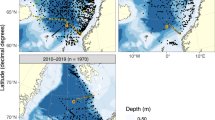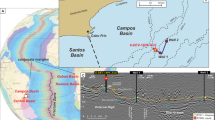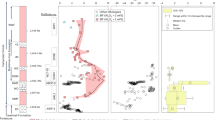Abstract
LITTLE is known about the occurrence of indium in the marine environment. Shaw1 succeeded in detecting it at concentrations between 0.06 and 0.28 p.p.m. in four of the eleven marine sediments that he examined. No figures seem to have been published yet for the occurrence of the element in seawater, although Baric and Branica2 have deduced from polarographic studies of saturated solutions of indium in seawater medium that its concentration should be 10−10 M. We have determined indium at four depths in the water column at Discovery Station 6917 (23° 00′ N, 18° 42′ W, depth 3,100 m). ‘Millipore’ filtration (0.45 µm) and preliminary concentration of the indium (by means of chelating ion exchange3) were carried out at sea immediately after the samples had been collected. The recovered indium was purified by anion exchange using ‘Dowex AG2–X8’ and then irradiated with thermal neutrons at a flux of 5 × 1012 neutrons cm−2 s−1 for four weeks. The irradiated sample was taken up in concentrated hydrochloric acid, equilibrated with 15 mg of inert indium as carrier and submitted to a twelve stage radio-chemical separation to free the 114In from other radioactive species. Indium was converted to its oxinate for determination of the chemical yield (∼ 60 per cent) and for β-counting. The identity of the separated 114In activity was confirmed by measurement of the half-life, plotting an aluminium absorption curve, and by γ-spectrometry. The concentrations of indium found at depths of 2, 500, 1,000 and 2,000 m were 0.31 ± 0.02, 0.12 ± 0.01, 0.10 ± 0.01 and 0.11 ± 0.01 ng/l. respectively. These concentrations are of the order of a hundred times less than those predicted by Baric and Branica2. Neutron activation analysis was also used to determine indium in three deep sea sediments. The concentration of indium found in the argillaceous sediment is identical with that found by Shaw1 in a red clay from the Equatorial Pacific. He was, however, unable to detect indium in a siliceous ooze or in a calcareous ooze.
This is a preview of subscription content, access via your institution
Access options
Subscribe to this journal
Receive 51 print issues and online access
$199.00 per year
only $3.90 per issue
Buy this article
- Purchase on SpringerLink
- Instant access to full article PDF
Prices may be subject to local taxes which are calculated during checkout
Similar content being viewed by others
References
Shaw, D. M., Geochim. Cosmochim. Acta, 2, 185 (1952).
Baric, A., and Branica, M., Limnol. Oceanog., 14, 796 (1969).
Riley, J. P., and Taylor, D., Anal. Chim. Acta, 40, 479 (1968).
Author information
Authors and Affiliations
Rights and permissions
About this article
Cite this article
MATTHEWS, A., RILEY, J. Occurrence of Indium in Seawater and some Marine Sediments. Nature 225, 1242 (1970). https://doi.org/10.1038/2251242a0
Received:
Issue date:
DOI: https://doi.org/10.1038/2251242a0
This article is cited by
-
Determination of indium in natural waters by flow injection inductively coupled plasma mass spectrometry
Journal of Earth System Science (1998)
-
Bibliography section
Journal of Radioanalytical Chemistry (1971)



